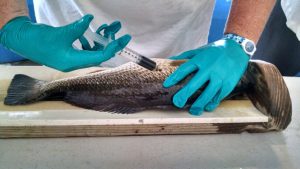Study Investigates Species-Specific Differences in Fish Metabolism of Deepwater Horizon Oil
– FEBRUARY 20, 2018
Researchers analyzed the metabolic capability of three Gulf of Mexico fish species after being exposed to toxic polycyclic aromatic hydrocarbon (PAH) compounds. Florida pompano exhibited faster biotransformation rates for hydroxylated naphthalene and phenanthrene compounds than red drum and southern flounder. These results suggest lower susceptibility to these compounds in pompano and higher susceptibility in red drum and southern flounder. The researchers published their findings in Environmental Toxicology and Chemistry: Species-specific metabolism of naphthalene and phenanthrene in 3 species of marine teleosts exposed to Deepwater Horizon crude oil.
Previous studies have shown that naphthalene and phenanthrene, the two most abundant PAH compounds identified in Deepwater Horizon crude oil, can be acutely toxic in fish depending upon the amount and duration of exposure. While fish have a relatively high capacity to metabolize PAHs, hydroxylated PAHs (OH-PAHs) formed during the metabolic process have a higher toxicity than their parent compounds and, therefore, pose a greater potential to harm fish health. “How quickly fish are capable of biologically transforming these chemicals, the resulting byproducts, and the rate at which they are eliminated can all impact overall organismal health,” explained study author Erin Pulster.
The team injected Macondo crude oil into adult red drum, Florida pompano, and southern flounder (which represent the estuarine, pelagic, and benthic life histories, respectively), and analyzed bile for monohydroxylated naphthalene and phenanthrene using gas chromatography-tandem mass spectrometry (GC-MS/MS).
Pulster explained that intraperitoneal injections offer valuable knowledge in terms of species-specific differences in metabolic capabilities without the hindrance of physio-chemical characteristics that may govern the uptake of a chemical. “This portion of the study evaluated species-specific differences in PAH metabolism which will then be used for comparison against additional exposure studies (e.g., gill, skin, ingestion) currently in progress. In addition, intraperitoneal exposures allow for the estimation and prediction of potential species that may be more susceptible to certain compounds based on their biotransformation rates and capabilities.”
The author noted that a wide range of oil concentrations were measured throughout the Gulf of Mexico after the spill depending on the component measured (e.g., hydrocarbons, PAHs, biomarkers), timing and location of sampling, and matrix sampled. “Our team used the dosage of 2 ppm crude oil, which falls within the range of environmentally-relevant concentrations measured in the water column (0 – 7,270 ppm TPH and <0.056 – 154 ppm PAH; Wade et al., 2016) and sediments (5 – 337 ppm aliphatics; 0.7 – 96 ppm hydrocarbons, 0.04 – 15 ppm PAHs; Romero et al., 2015, 2017).”
Monohydroxylated phenanthrene dominated red drum and southern flounder metabolites 24 hours post-injection, while OH-naphthalene dominated Florida pompano metabolites. At 72 hours post-injection, OH-naphthalene concentrations were 63-times higher and OH-phenanthrene concentrations were over 200-times higher in Florida pompano than at 24 hours. Similarly with red drum, OH-naphthalene increased by a factor of 13 and OH-phenanthrene increased by a factor of 3 at 72 hours compared to 24 hours. The compound 1-hydroxyphananthrene exhibited the highest concentrations across all three species, suggesting that it may be the principle biotransformation product regardless of species or exposure route.
“Understanding these species-specific differences in lifestyle and chemical metabolism is essential to identify which species may be more at risk to experiencing adverse health consequences as a result of oil exposure,” explained Pulster. “Ultimately, being able to identify the populations that are more at risk based on their habitat and physiology will help oil spill responders prioritize clean-up efforts.”
Data are publicly available through the Gulf of Mexico Research Initiative Information & Data Cooperative (GRIIDC) at doi:10.7266/N7057CZW.
The study’s authors are Erin L. Pulster, Kevan Main, Dana Wetzel, and Steve Murawski.
************
This research was made possible in part by a grant from the Gulf of Mexico Research Initiative (GoMRI) to the Center for the Integrated Modeling and Analysis of Gulf Ecosystems II (C-IMAGE II).
The Gulf of Mexico Research Initiative (GoMRI) is a 10-year independent research program established to study the effect, and the potential associated impact, of hydrocarbon releases on the environment and public health, as well as to develop improved spill mitigation, oil detection, characterization and remediation technologies. An independent and academic 20-member Research Board makes the funding and research direction decisions to ensure the intellectual quality, effectiveness and academic independence of the GoMRI research. All research data, findings and publications will be made publicly available. The program was established through a $500 million financial commitment from BP. For more information, visit https://gulfresearchinitiative.org/.
© Copyright 2010-2018 Gulf of Mexico Research Initiative (GoMRI) – All Rights Reserved. Redistribution is encouraged with acknowledgement to the Gulf of Mexico Research Initiative (GoMRI). Please credit images and/or videos as done in each article. Questions? Contact web-content editor Nilde “Maggie” Dannreuther, Northern Gulf Institute, Mississippi State University (maggied@ngi.msstate.edu).






